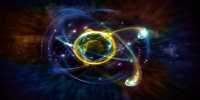If a tree falls in a forest and no one can hear it, what does it sound like? Probably not, say something. In addition, if anyone hears it? If you think this means it has clearly made a word, you may need to correct this opinion. One of our two most basic scientific theories – Einstein’s theory of relativity – we have found a new paradox in quantum mechanics – which casts doubt on the notion of some common sense about physical reality.
Quantum mechanics vs common sense
Look at these three statements:
When someone observes an event happening, it really happened.
It is possible to make free choices, or at least, statistically random choices.
A choice made in one place cannot instantly affect a distant event. (Physicists call this “locality”.)
These are all intuitive concepts and are even widely believed by physicists. However, our research published in natural physics shows that not all of these can be true – or that quantum mechanics itself has to break down at some level.
This is the strongest result of a long series of discoveries in quantum mechanics that challenge our notions of reality. To understand why this is so important, let us look at this history.
The battle for reality
Quantum mechanics works extremely well to describe the behavior of small objects such as atoms or light particles (photons). However, that behavior is very odd. In many cases quantum theory does not provide precise answers to questions such as “Where is this particle now?” Instead, it only provides the probability for where the particle can found if observed.
For Niels Bohr, one of the founders of the theory a century ago, this is not the reason for our lack of information, because physical features such as “position” do not exist in reality until measured. What’s more, because some properties of a particle cannot fully observe together – such as position and motion – they cannot be real at the same time.
This idea of a person less than Albert Einstein found to be obsolete. In a 1935 article with co-theorists Boris Podolsky and Nathan Rosen, he argued that there must be more to reality than what quantum mechanics could describe. The article considers a pair of distant particles in a particular state that now known as an “involved” state. When the same property (say, position or velocity) measured in both involved particles, the result will be random – but there will be a relationship between the results of each particle.
For example, an observer measuring the position of the first particle can fully predict the result of measuring the position of a distant position without even touching it. Alternatively, the observer may choose to predict the velocity instead. Contrary to Bohr’s interpretation, they had a natural explanation, arguing that if both properties existed before the measurement. However, in 1964 the Northern Irish physicist John Bell discovered that Einstein’s argument was shattered if you conducted a more complex combination of different measurements in two particles.
Bell showed that if two observers randomly and individually chose one or the other property of their particles as a measure of position or velocity, the average results could not explained in any theory where both position and motion had locally existing properties.
While this may seem unbelievable, experimental tests have now concluded that Bell has a correlation. For many physicists, this proves that Bohr was right: physical properties do not exist until they measured. However, it raises the important question: what is so special about “measurement”?














